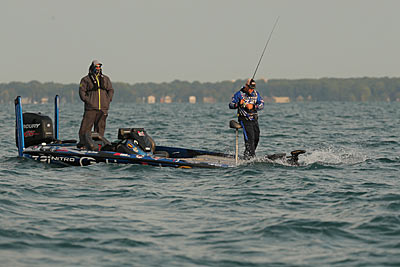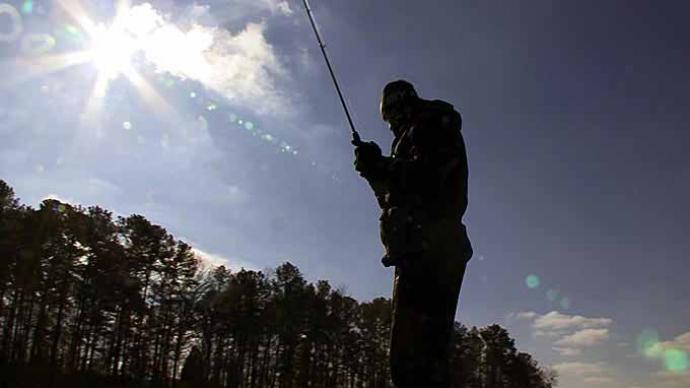
Jamie Hartman knows what it’s like to go through a rough patch. After a strong rookie campaign on the Bassmaster Elite Series in 2017, which he kicked off with a second-place finish at Tennessee’s Lake Cherokee, he started 2018 strong. He cashed checks in four of six B.A.S.S. events, including one in his first Bassmaster Classic and an eighth place at Lake Travis in late May. But he was sidelined by an injury after the Sabine River Elite event in early June, forcing him to take a medical exemption for the remainder of the season. He plans to spend the time addressing the injury and come back stronger in 2019.
While his injury is a much more significant obstacle, that same attitude can get you through the tough fishing that follows the passage of a cold front. Times will be good, then they’ll turn sour before slowly coming back. But in between, Hartman said there are ways to improve lousy fishing.
Cold fronts bring change
Meteorologically speaking, a front is the leading edge of an air mass. There are warm and cold fronts, which are named according to how the temperature changes after they pass. A cold front, for example, ushers in the air colder than what was there before its arrival.
The air behind the cold front also is denser, forcing up the warmer air, which can ignite storms, some of which can be strong. And there is always plenty of wind.
Once the front has passed and the colder air mass settles in, the skies become bluebird, and the wind settles, often to a complete stop. And that’s when fishing takes a turn for the worse. Hartman said fishing usually remains strong during the front’s passage and the next day. “It’s the second and third days when it gets tough,” he said.
But like most things in life, the tough fishing doesn’t last. Hartman said the weather usually stabilizes after the third day, putting the bass back in a biting mood.
Summertime cold fronts are the worst.

“It’s an all too familiar scenario,” Hartman said. An angler has a great tournament prefish, establishing patterns and enjoying plenty of bites. Then a cold front arrives at the start of the multiday tournament. While that can screw up the best-laid plans at any point during the year, the havoc is always the worst in summer.
Hartman said that in spring, fall, and winter, the water temperature is already cool, so a blast of cold air isn’t going to change it much. And those seasons see fronts pass quickly, leading to unstable weather. Bass become conditioned to constant temperature and barometric changes.
Summer brings longer stretches of stable weather, and bass adjust their movements, locations, and feeding to them. So, when a cold front arrives, the change feels even more significant. “It still affects the fish, no matter what season you get a cold front,” Hartman said. “But you get a 20- or 30-degree drop in air temperature during summer, and that’s huge. In the warmer months [a cold front] hurts the most.”
How bass react to a cold front
According to Hartman, anglers shouldn’t fear a cold front’s arrival. The change in conditions — more wind and a chance of storms — keeps bass feeding. That results from clouds and wind-ruffled water creating a low-light situation, which increases a bass’s willingness to chase down and strike lures. Good fishing usually lasts through the first day after the cold front’s passage.
Hartman said that bass hit the brakes on the second and third days when high air pressure dominates, the temperature bottoms out, the wind dies, and the sky turns bluebird. These conditions shrink their strike zone, keeping them tighter to cover and less willing to run down lures unless provoked. But how much it shrinks depends on where the bass swim in the water column.
Bass are affected by high pressure less as their depth increases, as stated by Hartman. The water above them acts like insulation, mitigating decreasing temperatures and increasing amounts of sunlight. When he sees a cold front in the weather forecast, he spends more time locating deep-water bass before its arrival.
Hartman said having those deeper spots in his back pocket is vital, especially during a tournament. That’s because once the high-pressure system settles overhead, shallow bass will become extremely difficult to catch. He said the sunlight and temperature changes hit them hard with less water overhead.
According to Hartman, all bass —largemouth, smallmouth, and spotted — are affected by post cold front high pressure. “They are all going to feel it for sure,” he said. Smallmouth may appear to be an exception because they are often caught in slightly deeper water. But he said that they can still be hard to catch if the wind dies and the water’s surface turns slick. Even a little ripple can make a big difference in what you catch.
Hartman cut his tournament-fishing teeth in New York and other northern states. But since joining the Bassmaster Elite Series, he’s spent more time fishing Southern waters and has planted new roots in Arkansas. That gives him a unique perspective. He has noticed that the farther south a bass lives, the greater effect higher barometric pressure has on it. “[Northern bass] handle it better,” he said.
Not all cold fronts are created equal. Hartman said that the faster they move, the less damage they inflict. And that means getting back to better fishing sooner.
How to change your approach
According to Hartman, techniques and patterns that were catching bass right before the cold front will continue to produce as it slides through and often through the first day after its passage. But eventually, you’ll have to change your approach. And he begins with his retrieve.

If Hartman has a power-fishing pattern before the cold front, he’ll stay with it in hopes of generating a reaction strike. If he’s fishing a square-bill crankbait, for example, he’ll make it deflect off more pieces of wood or rocks. While a bass feeling the effects of high pressure may watch it swim by, the erratic action and momentary pauses that follow a deflection can make it eat.
Once the second day rolls around and the high pressure takes complete control, Hartman switches to finesse approaches. That includes smaller lures, more natural colors, and slower presentations. If he had been catching bass on a big jig, he’ll change to a smaller finesse version and see if it gets bit.
Bass move under high-pressure conditions, especially toward heavier cover such as clumps of aquatic vegetation, thicker bushes, or way underneath a dock. Don’t be afraid to present your lure in the heaviest cover you can find. Switching to braided line, which offers more strength with less diameter, can ease fears of breaking off bass on the thinner lines that finesse lures demand.
If the cover lacks or has the same density, look for deeper water. For example, summertime bass that have settled onto a shallow flat aren’t going to swim out to a significant drop-off. But they will relocate to a ditch or depression a short distance away. It doesn’t have to be much deeper than the water they are leaving. Even 6 inches or a foot can be enough.
Let your lure soak in one spot. Adding too much action can turn off bass, but having it sit in one place, maybe batted around by the current, will bother bass into striking.
But probably the most significant thing you can pull out of your tackle box is patience. It’ll be slow fishing until weather conditions stabilize or the next front rolls through. But if you apply some, you’ll catch your share until then.




